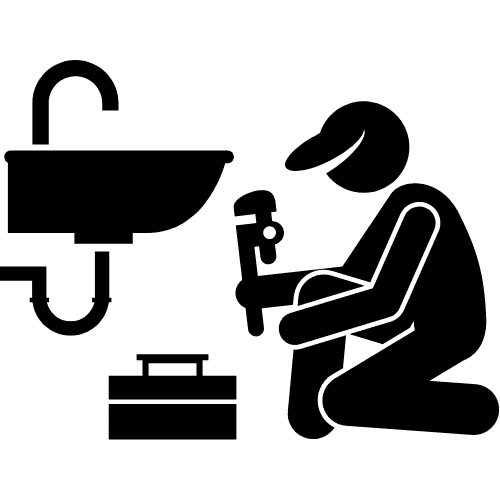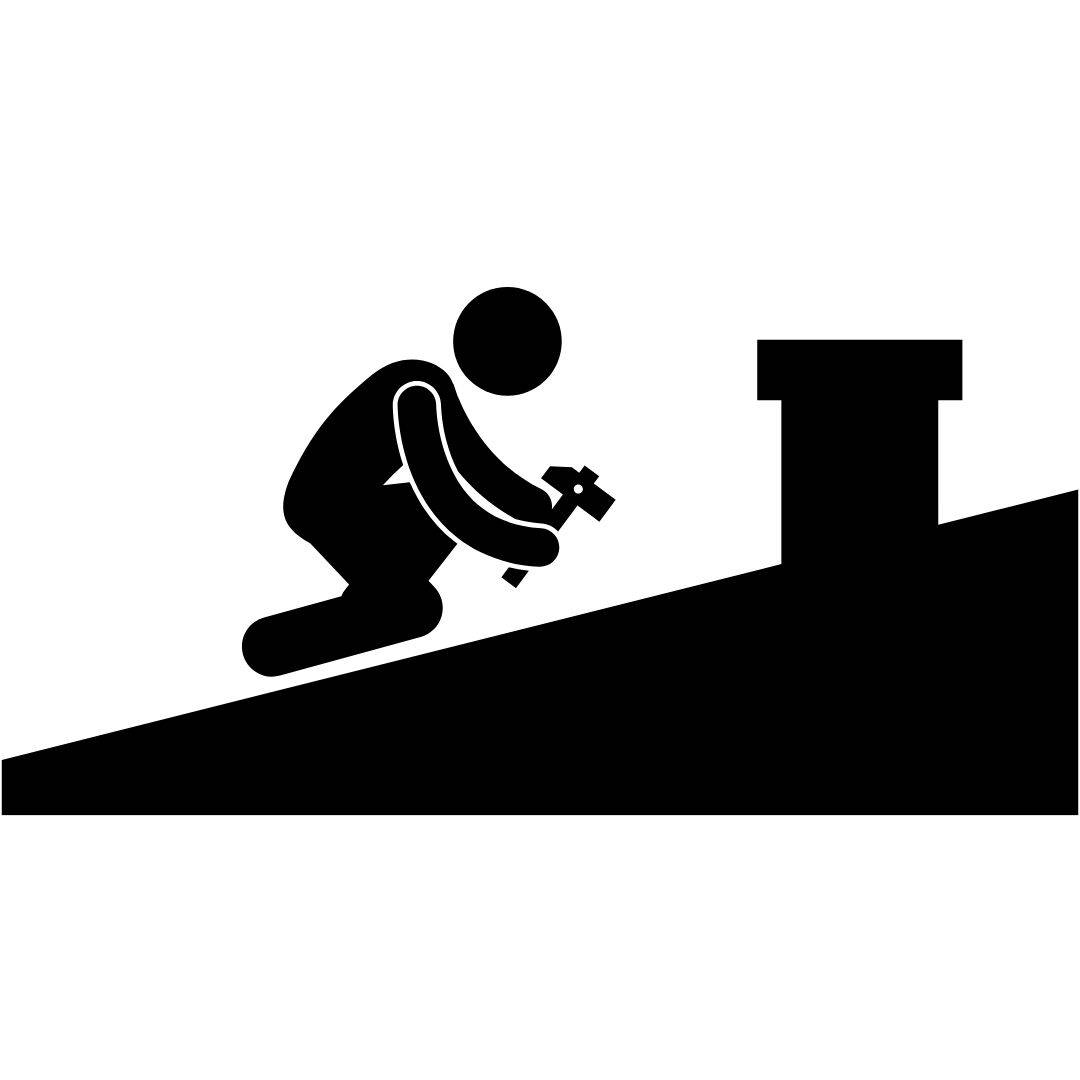Commercial Plumbing Contractor
Estimate Florida consulting as a plumbing estimator is here to allow you to achieve new levels of productivity and efficiency in budgeting and takeoff, giving your plumbing contracting company the boost it needs to not only survive but profit in these difficult economic times.
Our plumbing estimators are here to provide fast and accurate investigations to ensure their customers can submit an accurate and competitive price estimate.
Bid more win more!
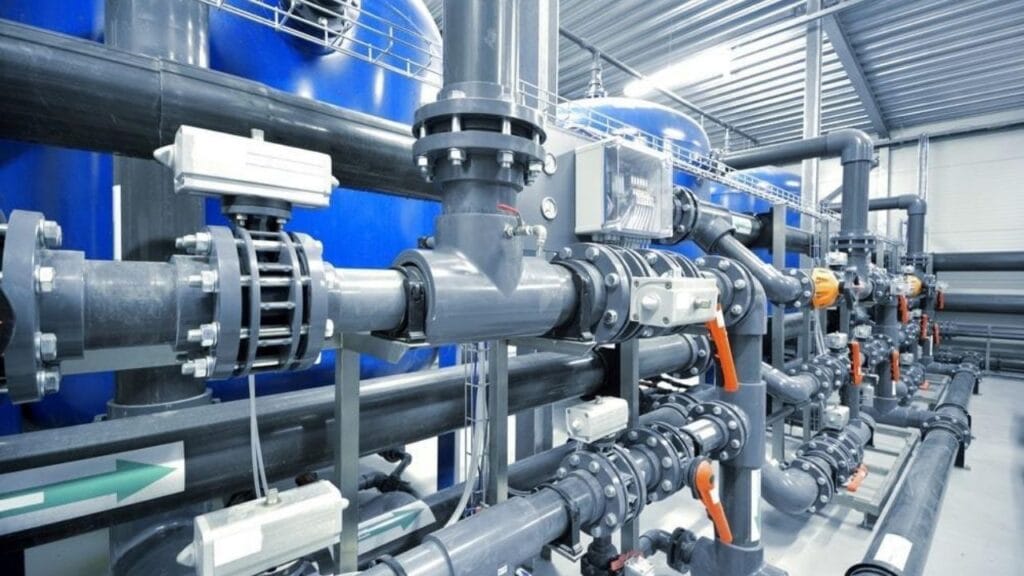
Frequently Asked Questions ( FAQs)
Commercial plumbing deals with more than just simple faucet and pipe installation and repair. Commercial plumbers are involved with the installation and maintenance of extensive waste removal and water supply systems for different forms of businesses and large housing complexes. The installation work of a commercial plumbing group may include the installation of drinking fountains, bathroom and kitchen fixtures, sprinkler systems, and water and sewer lines.
| Building Dimensions (feet) | Square Footage | Estimate Building Cost |
|---|---|---|
| 40×80 | 3,200 | $32,750 |
| 50×100 | 5,000 | $45,500 |
| 60×100 | 6,000 | $54,600 |
| 100×150 | 15,000 | $136,500 |
Ensuring the smooth operation of your business facilities is one of the most important services that a commercial plumbing service can provide you. Having access to a commercial plumber will ensure that any necessary installations, repair, service and replacements to your plumbing equipment can be done in a timely fashion. Commercial plumbers can deal with problems that relate to not only your plumbing fixtures but your roof drains, septic tank, water heaters, grease traps, water and gas lines.
Our professional commercial plumbing estimators are highly experienced and trusted ones. We work with ZIP code tracking to prepare an accurate estimate report for labour and material estimates.
Our in-house construction estimating service helps to understand the detailed estimate report.
Videos For Plumbing
Bardominium Plumbing
Bathroom Building
Bathroom Transformation
Commercial Plumbing Works
commercial plumber can provide is inspecting your gas lines and perform any necessary preventative maintenance. Along with doing visual inspections, commercial plumbers can also used advanced leak detection methodologies such as video, audio and static detection systems. This will help to ensure that your commercial plumber identifies problems and potential problems before a major repair becomes necessary. Having a scheduled maintenance program in place will help to keep your plumbing and other systems working properly and will extend their life.
The commercial plumber contractor is tasked to make sure that the establishment has functional water supply and waste drainage lines. During the installation, plumbers may have to excavate trenches and lay pipelines that link the structures piping system to the local water main and sewage system. Professional commercial plumbers practice great care in ensuring that the water supply system is kept safe from contamination.

Commercial Plumbing Estimating
We here to help you scale your business, we will delivery you an accurate estimate for your plumbing projects, with material and cost. We totally understand the complexity of the job of commercial plumbers, therefore we carefully itemize all the components such as pipes, fittings, fixtures, valves, and various other accessories for multiple floors.
Our Portfolio for Commercial Plumbing Projects
- Commercial HVAC Systems
- Solar Hot Water Heating System
- Sewer, Gas & Water Lines
- Commercial Water Heaters
- Irrigation Systems
- Pumped Sewerage Reticulation
- Roof Water Catchment
- Landscape Watering Systems
- Swimming Pool Plumbing Systems
- Cold Water Reticulation & Pressurisation
- Hot Water Generation & Reticulation
- Fire Hydrant & Hose
- Sanitary Plumbing and Drainage
- Sub-Soil Drainage Systems
- Stormwater Discharge
- Water Conservation
- Water Filtration
- Recycled Water Systems
New Plumbing Pipe & Materials Costs
If you want to put new pipes in your home or you’re building a home, there are three types of new plumbing pipes available that are building-code-approved for homes—copper, PEX, and CPVC (chlorinated polyvinyl chloride). PEX and CPVC are both plastics and are excellent alternatives to pricey copper piping.
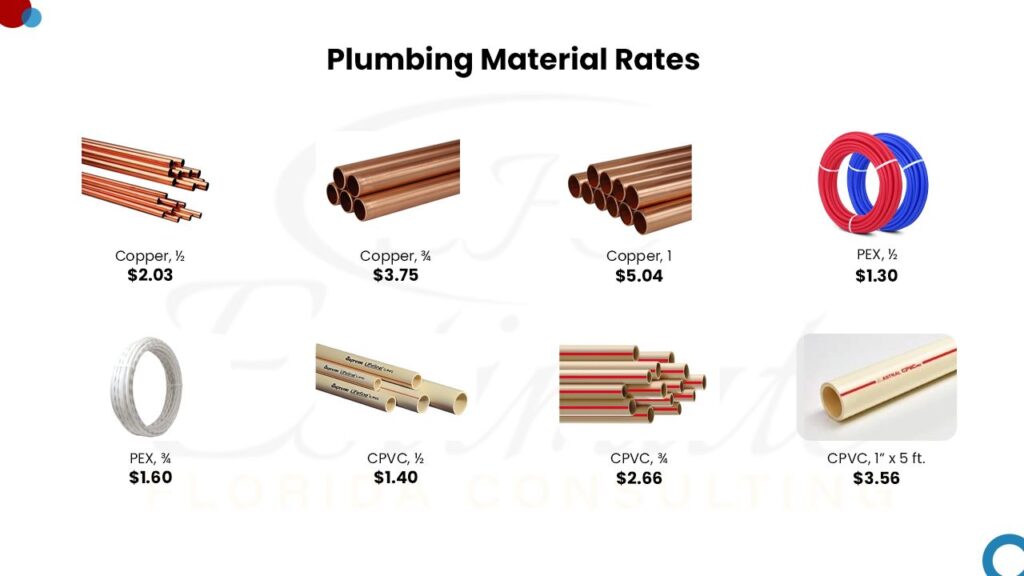
| Material | Price Per Linear Foot |
|---|---|
| Copper, ½” | $2.03 |
| Copper, ¾” | $3.75 |
| Copper, 1” | $5.04 |
| PEX, ½” | $1.30 |
| PEX, ¾” | $1.60 |
| PEX, ¾” | $1.60 |
| CPVC, ½” | $1.40 |
| CPVC, ¾” | $2.66 |
| CPVC, 1” x 5 ft. | $3.56 |
Systems
The major categories of plumbing systems are:
- potable cold and hot tap water supply
- hydronics, i.e. heating and cooling systems using water to transport thermal energy,
- plumbing drainage venting
- Rainwater, surface, and subsurface water drainage
- sewage systems and septic systems with or without hot water heat recycling and graywater recovery and treatment systems
- fuel gas piping
Water Pipes
A water pipe is a pipes or tube, frequently made of plastic or metal, that carries pressurized and treated fresh water to a building (as part of a municipal water system), as well as inside the building.
Cast iron and ductile iron pipe was long a lower-cost alternative to copper before the advent of durable plastic materials but special non-conductive fittings must be used where transitions are to be made to other metallic pipes (except for terminal fittings) in order to avoid corrosion owing to electrochemical reactions between dissimilar metals.
Bronze fittings and short pipe segments are commonly used in combination with various materials.
Difference between pipes and tubes
The difference between pipes and tubes is a matter of sizing. For instance, PVC pipe for plumbing applications and galvanized steel pipe are measured in iron pipe size (IPS). For instance, 1/2″ PeX tubing is the same size as 1/2″ copper tubing. 1/2″ PVC on the other hand is not the same size as 1/2″ tubing, and therefore requires either a threaded male or female adapter to connect them. When used in agricultural irrigation, the singular form “pipe” is often used as a plural. Copper tube, CPVC, PeX and other tubing is measured nominally, basically an average diameter. These sizing schemes allow for universal adaptation of transitional fittings.

Commercial Plumbing Estimator
We help Residential & Commercial Contractors to win more projects with higher accuracy.
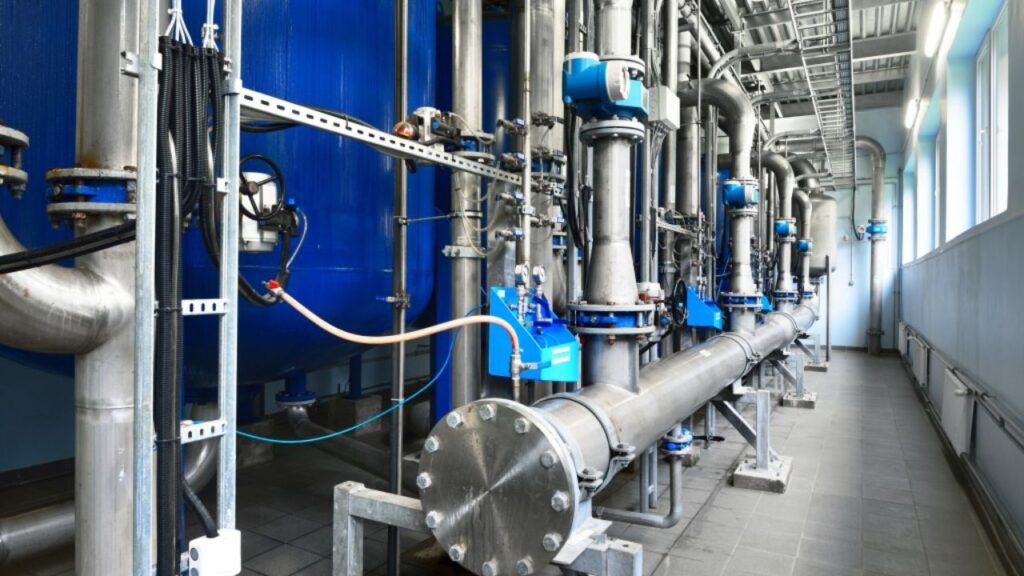
Materials
Water systems of ancient times relied on gravity for the supply of water, using pipes or channels usually made of clay, lead, bamboo, wood, or stone. Hollowed wooden logs wrapped in steel banding were used for plumbing pipes, particularly water mains. Today, most plumbing supply pipe is made out of copper, steel, and plastic; most waste (also known as “soil”) out of steel, copper, plastic, and cast iron.

The straight sections of plumbing systems are called “pipes” or “tubes”. A pipe is typically formed via welding, whereas a tube is made through extrusion. Pipe normally has thicker walls and may be threaded or welded, while tubing is thinner-walled and requires special joining techniques such as compression fitting, brazing, crimping, or for plastics, solvent welding.
Steel
Galvanized steel potable water supply and distribution pipes are commonly found with nominal pipe sizes from 3⁄8 inch (9.5 mm) to 2 inches (51 mm). It is rarely used today for new construction residential plumbing. Steel pipe has National Pipe Thread (NPT) standard tapered male threads, tapered threads on elbows, tees, couplers, valves, and other fittings. It remains in common use for repair of existing “galv” systems and to satisfy building code non-combustibility requirements typically found in hotels, apartment buildings and other commercial applications. It is also extremely durable and resistant to mechanical abuse. Black lacquered steel pipe is the most widely used pipe material for fire sprinklers and natural gas.

Most single family home systems won’t require supply piping larger than 3⁄4 inch (19 mm) due to expense as well as steel piping’s tendency to become obstructed from internal rusting and mineral deposits forming on the inside of the pipe over time once the internal galvanizing zinc coating has degraded. In potable water distribution service, galvanized steel pipe has a service life of about 20 to 50 years, although it is not uncommon for it to be less in geographic areas with corrosive water contaminants.
Copper

Types of Plastic
- PVC/CPVC – rigid plastic pipes similar to PVC drain pipes but with thicker walls to deal with municipal water pressure. PVC stands for polyvinyl chloride, and it has become a common replacement for metal piping. PVC should be used only for cold water, or for venting. CPVC can be used for hot and cold potable water supply. Connections are made with primers and solvent cements as required by code.
- PP – The material is used primarily in housewares, food packaging, and clinical equipment. PP pipes are heat fused, being unsuitable for the use of glues, solvents, or mechanical fittings. PP pipe is often used in green building projects.
- PBT – flexible plastic pipe which is attached to barbed fittings and secured in place with a copper crimp ring.
- PEX – cross-linked polyethylene mechanically systems joined fittings employing barbs, and crimped steel or copper rings.
- Polytanks – plastic polyethylene cisterns, underground water tanks, above ground water tanks, are usually made of linear polyethylene suitable as a potable water storage tank, provided in white, black.
- Aqua – for its PEX/aluminum sandwich, consisting of aluminum pipe sandwiched between layers of PEX, and connected with modified brass compression fittings.
Main Water Line Installation Cost per Foot
The main line for your water is considered a branch line from your town or city’s main line. It extends from the edge of the property to the water meter at your house. Because this distance changes by the property, costs are generally calculated by the linear foot. Several methods of installation or replacement and different materials and soil impact the cost per foot. Your main water installation ranges from $85 to $2,450 a foot, with most people paying between $120 and $230 a linear foot. The farther back from the road your home is located, the raise your project costs are.

| Main Line Length | Average Costs (Installed) |
|---|---|
| 10 Feet | $850 – $2,450 |
| 25 Feet | $1,975 – $6,625 |
| 50 Feet | $3,950 – $12,250 |
| 75 Feet | $6,625 – $18,875 |
| 100 Feet | $7,600 – $24,500 |
Commercial Plumbing Estimator
We help Residential & Commercial Contractors to win more projects with higher accuracy.
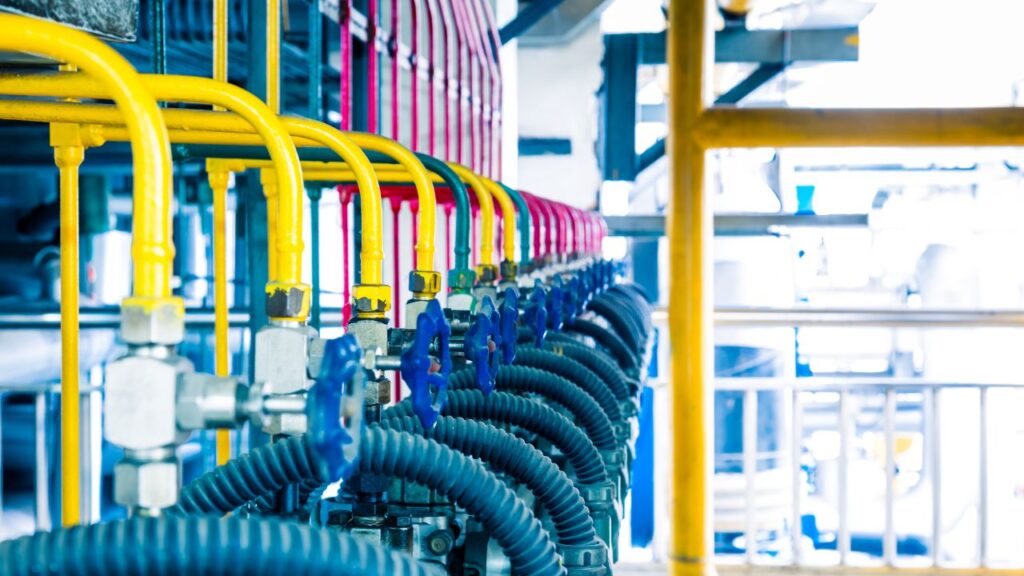
Labor Cost to Replace a Main Water Line
The bulk of the costs for this project comes from the waterline installation. While the material you choose for your line impacts the final costs, labor makes up the majority. There are two methods for installing or replacing a main water line from the street to your home. The first is digging and backfilling. A trench is dug in your yard so that the pipes can be accessed, laid, or removed. The second method is trenchless. Only two holes are dug, one near the street and one near your meter. The pipe is threaded through the ground between them. Because trenchless installations are easier, they are also less costly and less likely to disturb your property. Unless issues prevent this installation, it is the method people use.

| Installation Type | Average Replacement Cost per Linear Foot (Labor Included) |
|---|---|
| Trenchless | $75 – $150 |
| Digging and Backfilling | $175 – $250 |
Upload Your Plan For Estimate
Choose Your Trade & Get a Sample Project
Google Reviews

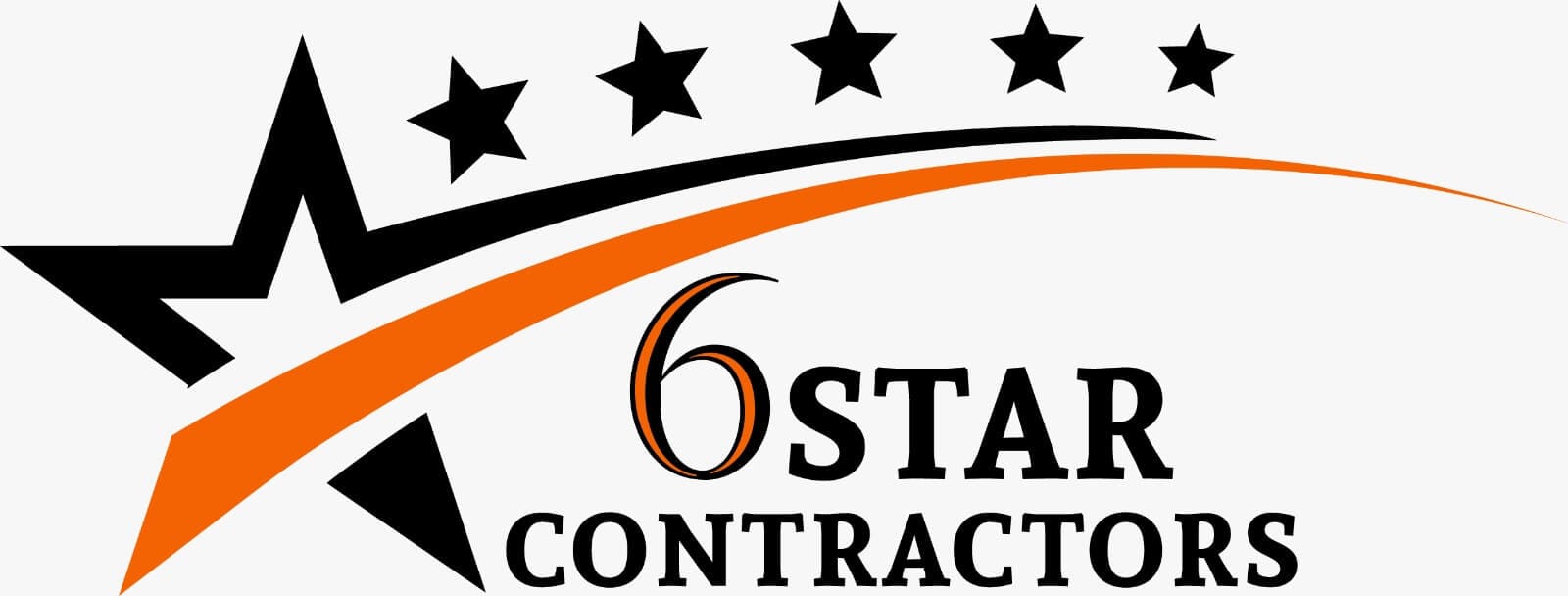

Why Choose Us
- You may save a lot of money on your project.
- Our estimate reports are highly accurate.
- We can make labour and material estimates in one or two days.
- Estimate Florida Consulting provides 24X7 customer support.
- Estimate Florida Consulting has worked with General Contractors, Sub Contractors, Developers, Architects, and Owners.
- Our charges are very affordable.
Process To Get Plumbing Estimate Report
Here I am going to share some steps to get your plumbing estimate report.
-
You need to send your plan to us.
You can send us your plan on info@estimatorflorida.com
-
You receive a quote for your project.
Before starting your project, we send you a quote for your service. That quote will have detailed information about your project. Here you will get information about the size, difficulty, complexity and bid date when determining pricing.
-
Get Estimate Report
We do plumbing estimating and prepare a detailed report for your project. At last you finalize the report and finish the project.







